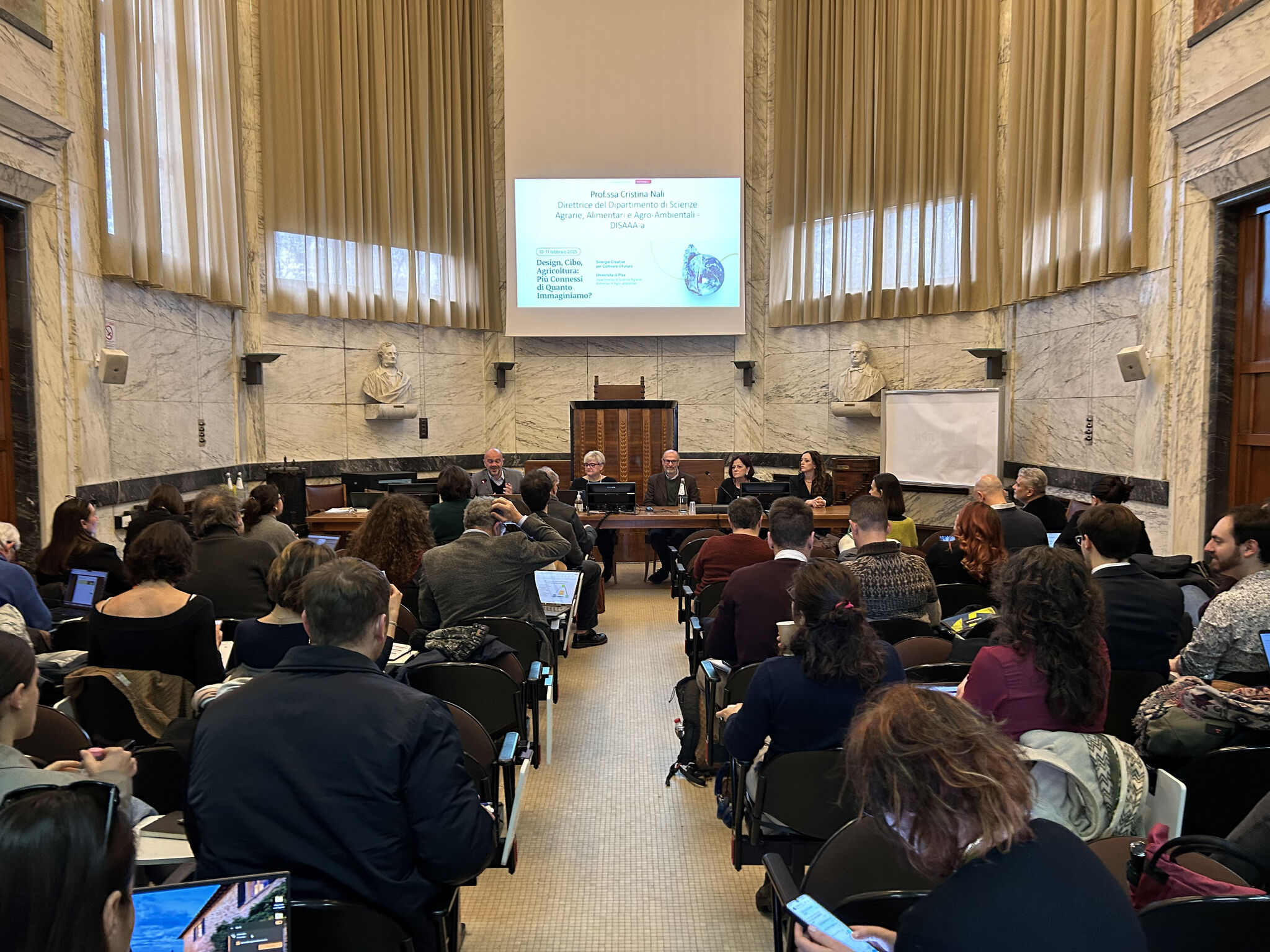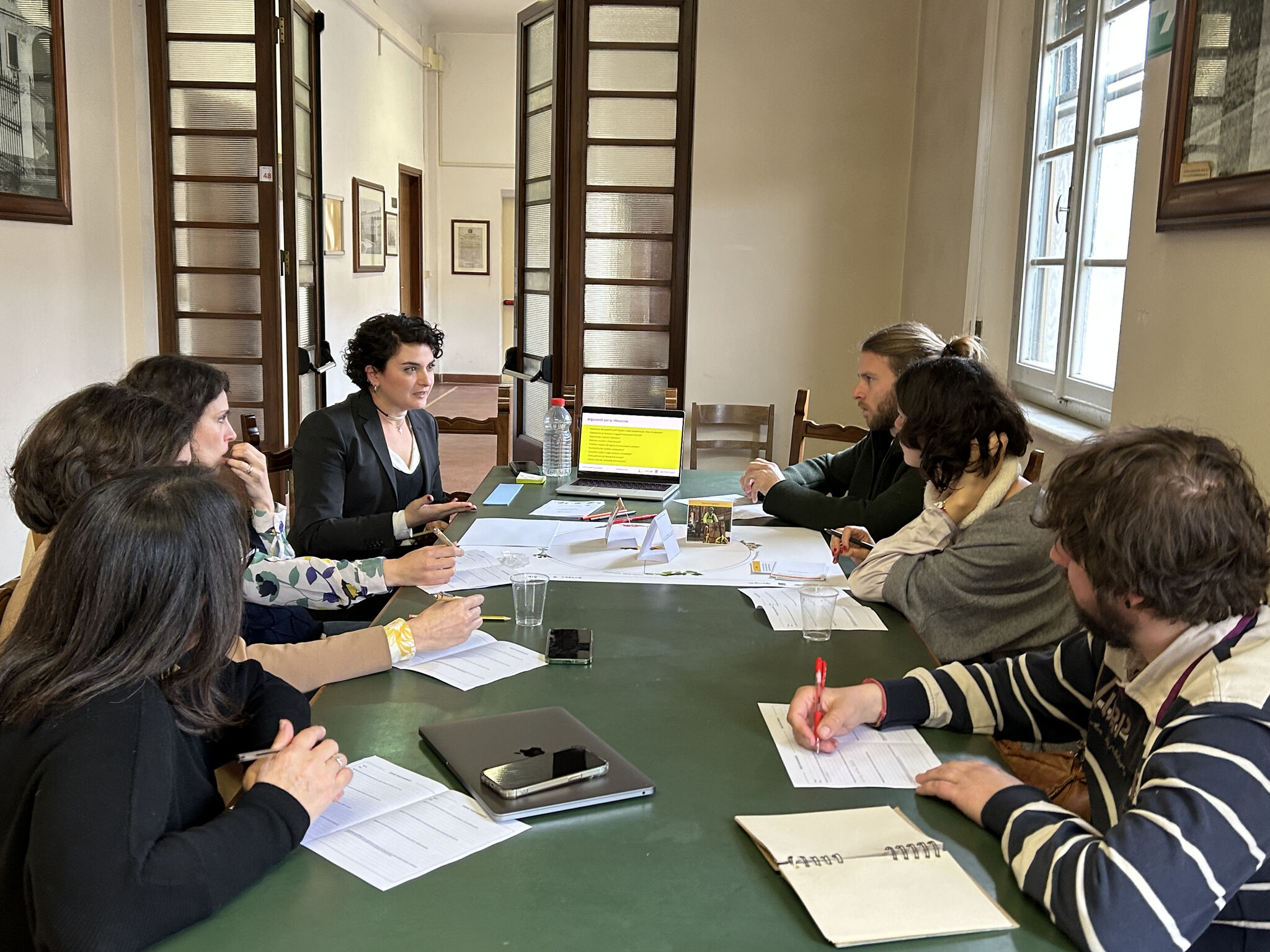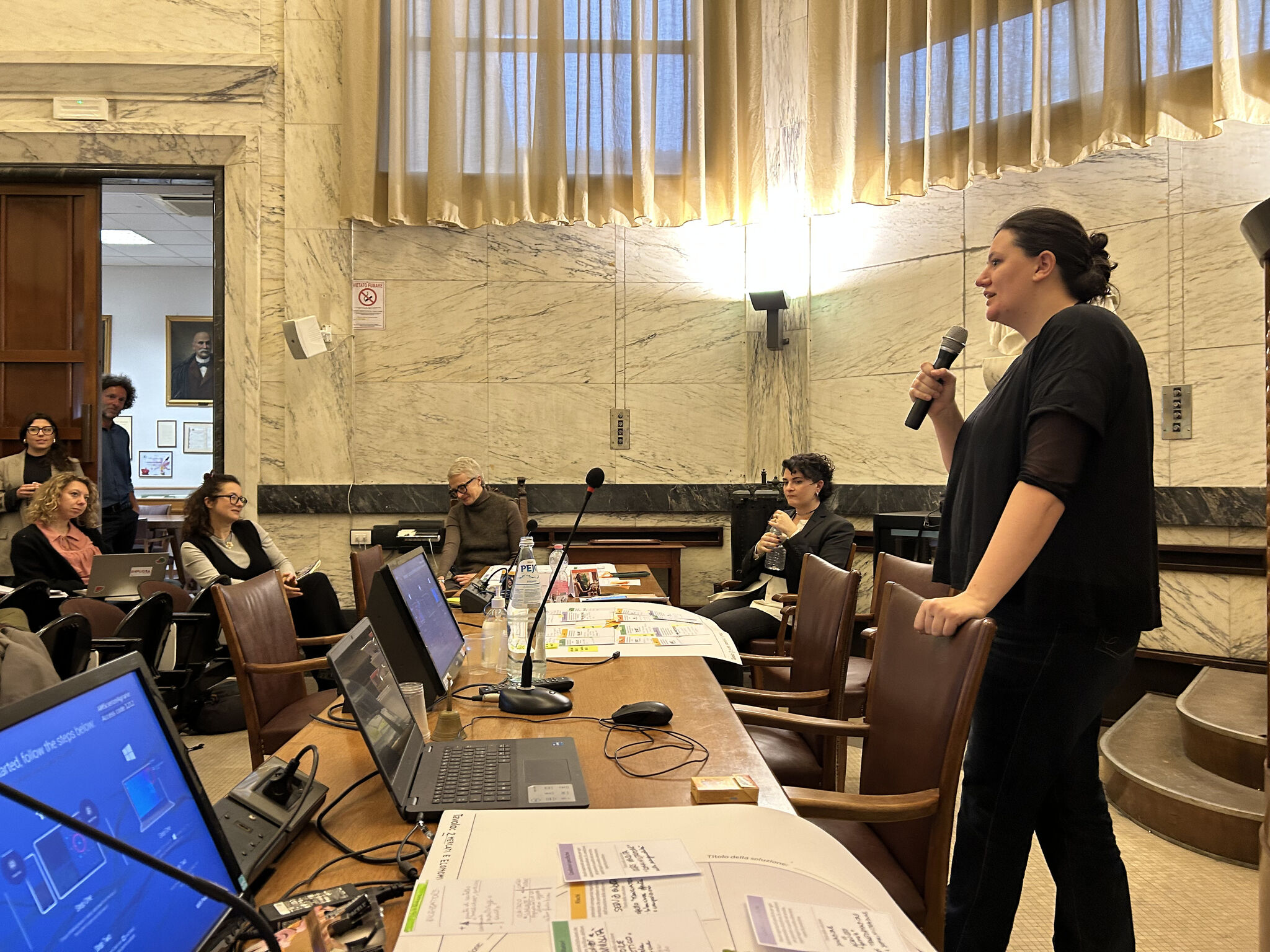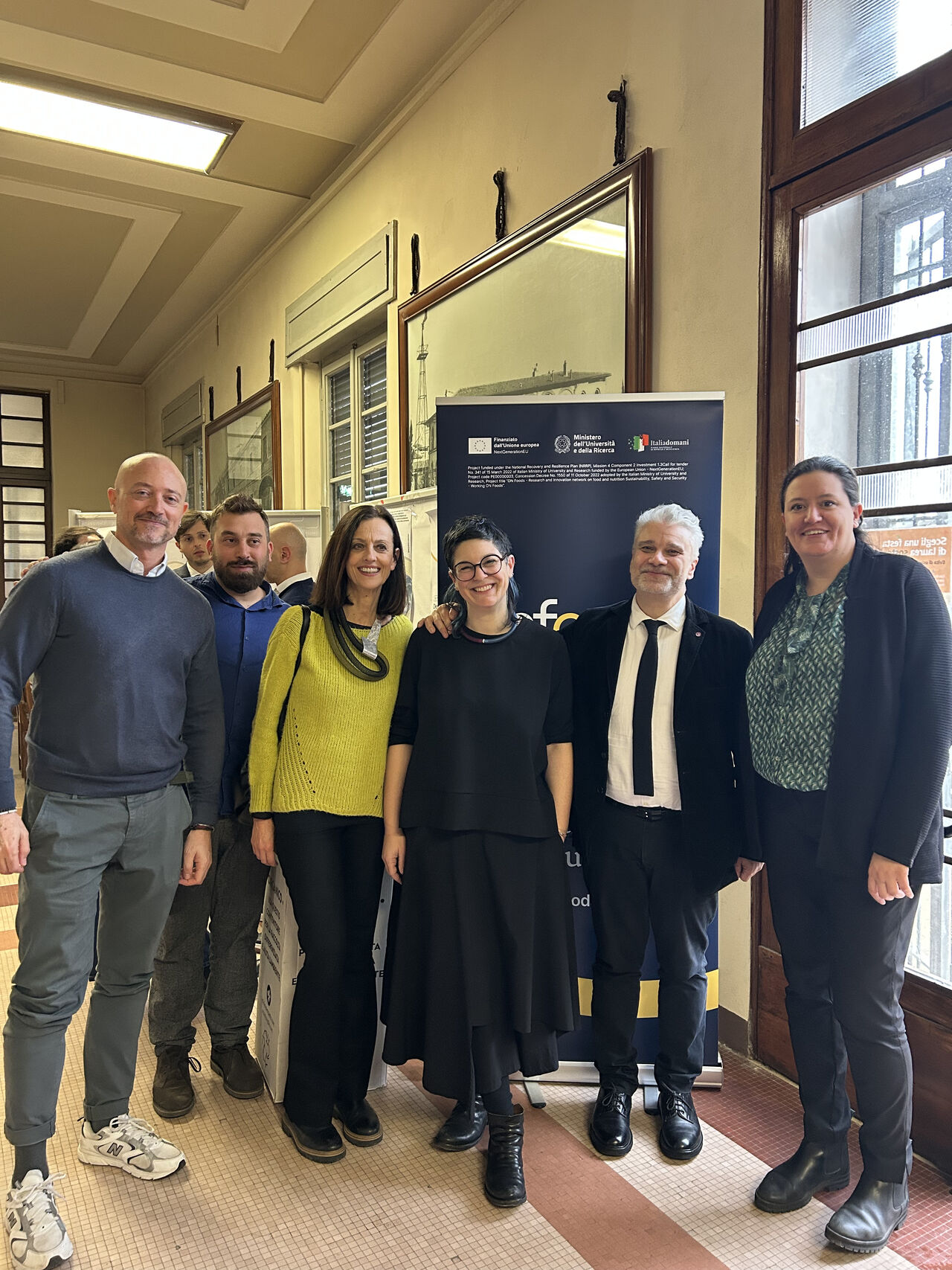Funded under the National Recovery and Resilience Plan (NRRP), Mission 4 Component 2 Investment 1.3, Theme 10.
Seeds of innovation: design for the agri-food transition at the Spoke 1 Conference at the University of Pisa
From imagining new agrifood scenarios to creating living labs, the “Design, Food, Agriculture” event ashowed how design is a bridge between disciplines, territories, and cultures.

Giulio Burroni
Communication manager
The relationship between design, food, and agriculture is closer than one might think. The event "Design, Food, Agriculture: More Connected Than We Imagine?", held on February 10-11, 2025, at the University of Pisa, brought together experts in design, agricultural economics, food policies, and entrepreneurship to explore the role of creative methodologies in transforming agri-food systems.
The two-day talks and workshops focus on how transdisciplinarity can support the transition toward more inclusive, sustainable, and resilient agri-food systems.
“This event – commented Cristina Nali, Director of the Department of Agricultural, Food and Agro-environmental Sciences at the University of Pisa – clearly showed how the synergies among science, technology, agriculture, and the environment are the driving force behind a more sustainable, efficient, and resilient agriculture. Over the two days, we shared ideas, discussed projects, and learned from the experiences of those who are already working, with passion and determination, for a future in which agriculture is not only an economic resource but also a pillar for the health of our planet.”

Designing Urban and Rural Agri-food Scenarios
The first day opened with the workshop: “Food Forward: Designing Urban and Rural Agri-food Scenarios", coordinated by the Polytechnic University of Milan and the Universities of Pisa and Parma. Participants worked on future food-related scenarios, paying particular attention to rural-urban dynamics and equitable access to food resources.
"During the workshop," commented Anna Meroni, coordinator of the SCIN-GO research project at the Polytechnic University of Milan, "we developed exploratory scenarios, imagining alternative directions for the future of Milan’s food system. We discussed and refined these scenarios with sector stakeholders, weaving shared paths and opportunities. The exchange in Pisa with the OnFoods expert community provided a critical perspective, bringing new ideas back to the Milanese context and paving the way for future design experiments."
In the afternoon, the plenary session addressed "Creative Methods for Research, Learning, and Teaching," highlighting the importance of design thinking in agri-food systems and transdisciplinary collaborations for more effective policies. Discussions also covered how design tools can be applied to food regulations, bioeconomy strategies, and agroecology.

Why Do Agricultural Sciences and the Agri-food Sector Need Creative and Design Methods?
The first day’s afternoon session demonstrated that design is not just a methodology. It encompasses interaction design, food policies, education, and integrated communication. It is a true catalyst for innovation in agri-food systems.
Food policies, for instance, can be improved by integrating design thinking into their development. Tarek Allali from the PAGE group at the University of Pisa discussed this concerning the World Food Programme.
Similarly, neglected species can be enhanced through agile prototyping applied to agroecology, as shown by the DIVINFOOD EU project and FIRAB, which focus on underutilised agricultural biodiversity to counteract biodiversity decline.
Communication, Branding, and Entrepreneurship Education in Agri-food
Professor Elena Rotondi (IUSVE and University of Udine), with the University of Pisa, led educational experiments that resulted in projects on new ruralities. The goal is to ensure equity in agricultural sciences and access to digital tools to make the regulations of the Tuscan Pecorino chain more accessible.
Another key theme was the importance of entrepreneurship education as a bridge between academia and the professional world. Strategic alliances like the CIRCLEU network and interdisciplinary spaces like the Contamination Lab offer students, researchers, and companies opportunities to experiment with innovative solutions, fostering new business models for the agri-food sector.
Many experimental approaches discussed in Pisa originated from the Tenuta Labs, field laboratories organised by the Department of Agricultural, Food, and Agro-environmental Sciences at the University of Pisa over the past two years. These labs involved leading farms such as Suvignano (a Tuscan estate confiscated from the mafia), Tenuta di Paganico (a flagship of Italian agroecology), and Vivid Farm (a regenerative farm in Portugal), which hosted OnFoods researchers during the Regenerative Food Design Bootcamp co-organized by FORK.
- See also the video: "La nuova ricerca sull’agrolimentare? È partecipata, empatica e co-creativa."
Creative Synergies for Cultivating the Future
The second day focused entirely on the relationship between innovation and sustainability in agriculture. The Paris Agreement principles have long guided global development goals, pushing for the transformation of food systems. However, transformation implies acknowledging the crisis of a previous model. "For us, innovation is what supports this transformation," stated Professor Gianluca Brunori, So, how can innovation be transformative?
Traditionally, economics distinguished between incremental and radical innovation. Today, Brunori explained, "We prefer to differentiate between conservative innovation, which patches up a failing system, and transformative innovation, which plants the seeds of change, whether radical or incremental."
Proposing transformation requires understanding societal movements and observing bottom-up processes in local food chains, neighbourhoods, and rural areas. Through design—as a discipline of interaction and orchestration—it’s possible to address change starting from people’s needs. "Many of our working group activities," added Professor Filippo Arfini, head of OnFoods' Spoke 1, "focus on short food supply chains. A few years ago, these were dismissed as niche concepts in academia. Yet, within niches, we find modest but meaningful innovation models."
"Innovation theories often discuss generativity," Brunori noted. "In a hyperconnected world, innovation opportunities multiply. Today, innovating means recombining existing elements—like a shoe transformed into a health monitoring tool. This principle of recombination drives the design era."
Where to start? "Disciplinary openness should not be feared but embraced as a key to making sense and creating a synthesis. That’s what design methods and approaches teach us," he concluded.
The morning’s reflection shifted to the new entrepreneurial and research culture needed for the agri-food sector to change. While food innovation is booming and many agri-food startups are emerging, Professor Alessio Cavicchi warned, "Many don’t survive beyond 18 months. So, what are we achieving? Where’s the problem?"
This question leads back to redefining entrepreneurship—not just creating financial value but "generating value for others." Hence, the European Commission insists on living labs across sectors, from agri-food to manufacturing and education. These labs are vital to bridging universities and society, enabling impactful entrepreneurship.
University living labs thus represent new collaborative models among academia, businesses, public administration, and civil society. Besides transferring research results, they promote participatory innovation, co-creating it with local actors. "Orchestrating all these competencies and sensitivities requires the participatory design methods we’ve discussed over these two days," Cavicchi concluded.
Building Scenarios to Imagine Possible Futures
Within OnFoods’ Spoke 1, one of the most active groups in participatory design is the Polimi DESIS Lab, from the global DESIS (Design for Social Innovation and Sustainability) network, represented in Pisa by researcher Marta Corubolo.
The lab uses scenario building to envision future developments, activate collaborations and propose innovative solutions. These scenarios—rooted in Milan’s food system context—identify key nodes in short food supply chains, exploring hybrid spaces and emerging innovation signals. For designers, these scenarios depict reachable near-future visions within a decade. Once developed, they become actionable through service prototypes, visualizations, and operational strategies.
"These are interpretations and speculations that tell alternative stories," said Corubolo, "provoking dialogue. Their goal isn’t a single solution but exploring multiple perspectives, embracing uncertainty as part of the process. Design thrives on the unfinished—open, evolving solutions."

Listening to stakeholders’ needs remains central. "Our work at the Department of Agricultural, Food, and Agro-environmental Sciences in Pisa, particularly with the PAGE group, highlights how resources act as catalysts for participatory processes," added Sonia Massari. "Testimonies from the Tenuta Labs show how collaborative creativity generates real-world, sustainable solutions."
Measuring and understanding how intangible resources like shared learning are managed in co-creation emerged as a significant challenge. Defining designers' roles is thus essential for improving living labs, where design meets real-world complexities.
The presentations also included Professor Gabriele Goretti (University of Pisa) on design’s role in transitioning to a circular economy and Professor Patrizia Marti (Santa Chiara Fab Lab, University of Siena) showcasing the GNAM research project, which turns corporate food museums into living labs. Professor Filippo Chiarello discussed AI-driven innovation and its impact on redesigning paradigms.

Introducing FARE.D LAB: The First Rural-Based Design Laboratory
FARE.D LAB (Food, Agriculture, Rural Enabling Design Laboratory) emerged from the need to bridge disciplines and foster collaboration between design, agrifood, and agricultural sciences. Presented by Sonia Massari during the event, it’s not just a lab but a true innovation platform developed within the OnFoods research framework.
"The word enabling is at the core of this initiative," Massari explained. "Design here is a catalyst—a bridge allowing different worlds to meet and work together. Too often, agrifood, agricultural sciences, and design operate in parallel. FARE.D aims to close that gap, providing a space where these fields can collaborate."
Behind the project is the PAGE research group, which includes experts in agricultural economics, food law, agronomy, geography, anthropology, sociology, food science, and food policy. The group aims to tackle sector challenges through a transdisciplinary approach, turning expert dialogue into concrete solutions.
Returning to the event’s guiding question—"Design, Food, Agriculture: More Connected Than We Imagine?"—the answer is a resounding "yes," provided design is understood as a practice that mediates between disciplines, territories, and cultures.
"The danger of an overly broad definition of design is attributing it with a miraculous power—as if it could solve any problem. In reality," emphasized Professor Lorenzo Imbesi (Sapienza University of Rome, President of SID – Italian Design Society), "the designer isn’t a solitary demiurge but an interpreter working through relationships, orchestrating diverse knowledge and sensitivities."
Quoting Hannah Arendt’s The Human Condition, Imbesi underlined that design is not an individual act but a process developing within a web of interactions:
"The designer is a cultural nomad—crossing boundaries, disciplines, and practices to build shared meanings in public spaces. The goal isn’t to offer final solutions but to create tools that navigate uncertainty and open new possibilities."

Giulio Burroni
Communication manager
Specialist in Communication and Project Management with over 8 years of experience in agency work. Currently involved in communication, branding, and design projects within the public administration, research institutions, and university sectors


